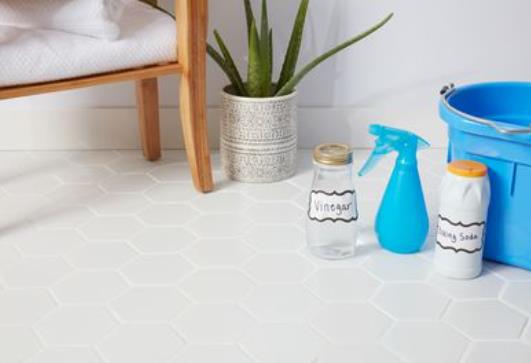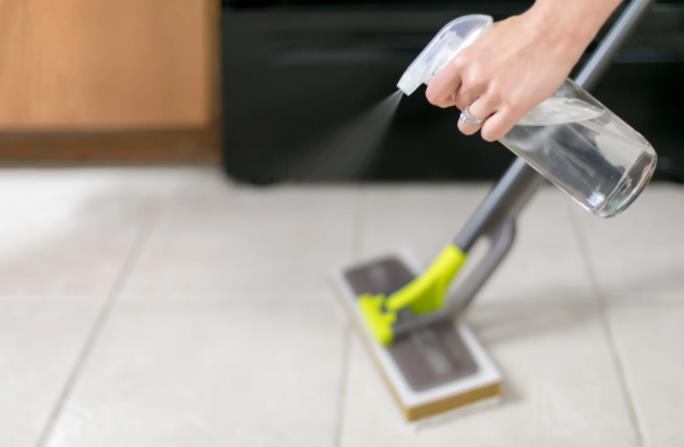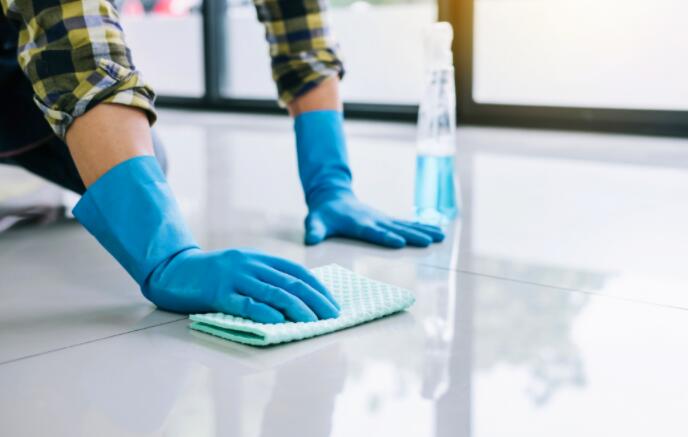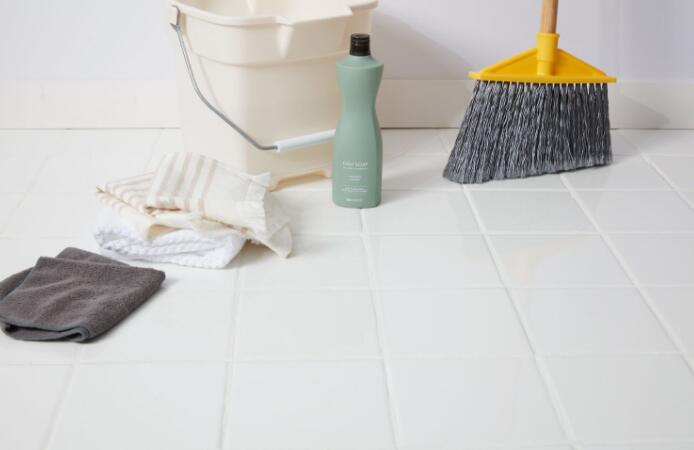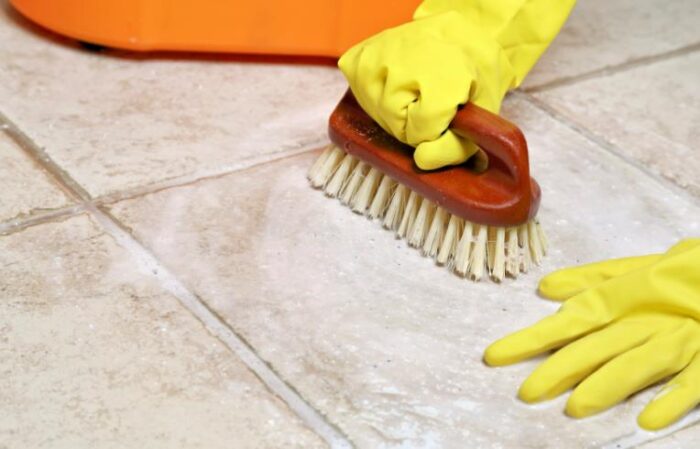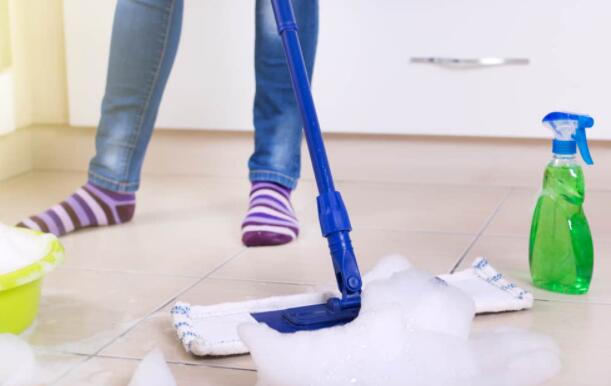Tiles have intrinsic designs, shinny appearances, and so on that add to a house’s beauty. Such a property makes tiles very popular. However, like everything else, tiles are prone to becoming dirty, with some to the extent of becoming repulsive. So, how to clean tile floors?
If you find yourself in a situation whereby your tile flooring starts becoming an eyesore, then you should probably consider cleaning it. Here are tips on cleaning your tile floors.
What Are the Best Tile Floor Cleaners?
Cleaning tile floorings is usually an easy thing as it does not require the use of complex equipment, as you will see in the below list of tile cleaning equipment.
- Vacuum
In your tile cleaning process, the equipment you will always use first of all will always be a vacuum. If you lack one, a broom and dustpan will work just as marvelously.
Turn on your vacuum and remove all the dirt and debris from your floor. Moreover, if your tiles are not that dirty, you can use them to clean the tile floors, then clean the tiles later.
- Mop
While cleaning your tile, you will require your mop. A clean rug might work, as well. However, it will do a number on your back, especially if the room is large. Dip your mop in water, wring it properly, and clean your flooring. It is as easy as that.
- Vinegar
For any tile, type give for marble and natural stone, vinegar will be the most effective cleaner you will ever find. Mix it with water and give your tiles a good scrubbing, and you will see the results for yourself.
However, never use it on marble and natural stone tiles least, you find them irreversibly damaged.
- Soft scrubbing bush
While cleaning tile floors, a soft scrubbing brush is a useful tool to have. It will ensure all the dirt on your floors is removed during the cleaning process without leaving scratch marks on your tiles.
- Baking powder
If your tiles are quite dirty or have stains that will not come off, always have baking powder.
As you will see later in the article, making a little baking powder paste will go a long way in cleaning your tile floors.
- Bucket of warm water
Though quite a no-brainer, no cleaning can progress without using water.
However, warm water will ease the process since warm water will help loosen the stains, especially fatty ones ensuring you do not stay cleaning floors the whole day.
- Personal protective equipment
If you are cleaning public spaces such as public washrooms or high traffic areas, always use personal protective equipment such as gloves as you do not know who passed there or used the washroom.
Doing so will ensure you can clean the flooring without worrying about infections.
How to Clean Tile Floors?
After determining the best tile cleaner for your needs, you have to know the type of tile you have; pick the most appropriate cleaning methods as below:
- Ceramic Tile
Though the popularity of ceramic tiles is due to their low maintenance and dirt resistance qualities, from time to time, they may become hazy and require cleaning. If so, you will need the following items:
Vacuum or broom and dustpan, Warm water, A mop
Tile floor cleaner, Baking soda, Microfiber cloth, Bucket
Cleaning Process
Remove as much debris and dirt from your tile surface using either a vacuum or broom and dustpan.
Step 1: Pour warm water into your bucket, then pour a small amount of tile floor cleaner.
Step 2: This step depends on the tile cleaner you have as some do not require mixing with water.
Step 3: Wipe the dirt off your tile floors by moping using your mop dipped in the warm water and tile floor cleaner solution.
Step 4: Dry and buff your tile floor using a microfiber cloth.
- If the stains have not come off, keep reading and following the next steps. If the problem is solved, you can skip this part.
Step 5: Make a thick paste from the baking powder and water.
Step 6: Apply the paste on the stains’ points, let it loosen the stains for a minute or so, and then use the microfiber cloth to scrub the spots.
Step 7: Use water to rinse the surface since baking soda tends to leave behind films.
Step 8: Buff and dry the area using a dry cloth.
- Porcelain Tiles
Porcelain like ceramic is famous due to its low maintenance and dirt-resistant nature. However, when they do need cleaning, you will need to consider whether yours are unpolished, polished, or textured.
- Cleaning unpolished Porcelain tile floors
Step 1: Remove debris and dirt from the tile surface by sweeping or vacuuming.
Step 2: Saturate the tile surface using your tile cleaner or a water-vinegar mixture and allow it to soak the stains for three or so minutes.
Step 3: Using a soft rag or brush, scrub the tile surface.
Step 4: Using warm water, rinse the tile surface to remove the cleaning solution.
Step 5: Use a dry microfiber cloth to buff and dry the tiled surface.
- Cleaning Polished Porcelain tile floors
Step 1: Remove debris and dirt from the tile surface by sweeping or vacuuming.
Step 2: Clean the tiled surface using a mop dampened with warm water.
- If the stains persist, keep reading and proceeding as the following steps. If the problem is solved, you can skip this part.
Step 3: Mix your preferred tile cleaner with water as per the stipulated ratios, or use a vinegar-water solution.
Step 4: Mop your tiled surface with the above mixture and ensure you re-mop with warm water before the former solution dries.
Step 5: Use a dry microfiber cloth to buff and dry the tiled surface.
- Cleaning Textured Porcelain tile floors
Step 1: Remove debris and dirt from the tile surface by sweeping or vacuuming.
Step 2: Mix your preferred tile cleaner with water as per the stipulated ratios, or use a vinegar-water solution.
Step 3: Let the solution soak the stains for about five minutes, then scrub using a soft rag or brush.
Step 4: Rinse the cleaned surface with warm water to prevent film formation
Step 5: Use a dry microfiber cloth to buff and dry the tiled surface.
- Marble Tiles
From its use by the ancient Romans to date, marble arguably gives the best flooring of any tiles as it is beautiful, elegant, prestigious, and eco-friendly. However, marble is very susceptible to staining due to its porous nature. In the event it becomes dirty, you will need:
Soft cloths, Dust mop, Bucket
Ammonia, 12% Hydrogen Peroxide, Water
Sealer, Marble tile cleaner
Cleaning process
Ensure you use no vinegar or any acidic solution in this process.
Step 1: Use a dry mop.
Marble tiles easily scratch, so never use vacuums on them as their wheels will damage your marble floors. Instead, use a dust mop and ensure you clean its head after each room to prevent the accumulation of dirt that will end up scratching your floor.
Step 2: Change a damp mop.
Mix your marble tile cleaner with water and use a clean, soft rag or mop to wipe the marble surface. Ensure that the cleaner you use is acid-free to prevent damage to the tile.
Step 3: Rinse and dry the tiles.
Remove any soap residues from the marble tiles using clean water, then dry the surface using a soft piece of cloth.
Step 4: Remove stains.
Once stains embed, they are usually an eyesore, and getting them out is usually a headache. Consequently, never let spills or stains set into it. But if they set in, spot clean using a clean piece of cloth dipped in a solution of a few drops of ammonia and 12% Hydrogen Peroxide.
Step 5: Remove etches marks.
Marbles get etch marks when an acidic product eats away at its surface. To clean this, wet the marble using clean water, then sprinkle marble polishing powder on it. Use a damp cloth to buff the powder into the marble till the marks disappear.
Step 6: Seal.
If sealing is required, buy a suitable one and follow the manufacturer’s instructions.
- Natural Stone Tiles
These tiles are generally made of natural stone as suggested by their names and are as strong as rocks. However, they are prone to damage when cleaned with acidic compounds such as vinegar.
Cleaning process
If you have a natural stone tile and it becomes dirty, you should:
Step 1: Use a broom or vacuum to remove the debris and dust from your natural stone tile.
Step 2: As most manufactured cleaning products may damage these tiles, use a suitable one as earlier indicated and, if need be, mix with water.
Step 3: Let the solution sit on the tile surface for a minute or so, then mop it off.
Step 4: Use a dry piece of cloth to dry and buff the surface.
You may find various types of stains persisting on the natural stone tile. If so, proceed as below:
- Cleaning Grease
Pat away the excess grease using a dry piece of cloth, then apply a layer of talcum powder on the tile’s surface, leave it there for a couple of hours, vacuum, or sweep it off.
If this fails, reapply the talcum powder and repeat the process after a more extended period. Even days if needed.
- Cleaning rust
In the vent of such a rare scenario, you will have to do the unthinkable and use an acidic detergent like lemon juice on your natural stone surface.
However, apply the solution carefully, leaving it on for a minute, then wipe it off with plenty of water let it dry naturally.
You should note that this may fail to remove the stains entirely or damage your tiles. Moreover, the tile may significantly lose its shine.
- Cleaning organic stains
Organic stains from drinks or food can also be challenging to remove. If they do occur, try using mild detergents to remove them.
If this fails, dab Hydrogen Peroxide on the affected area, but ensure you test this on a hidden spot as it may or may not generate horrific stains.
- Cleaning inks and paint
As with organic stains, this method will require you to test how your tile reacts with mineral alcohol or acetone before applying them on the affected spot.
- Vinyl tiles
Vinyl tiles are 100% made of polymer materials ensuring they do not warp even when subjected to excessive moisture. However, when cleaning, you will need:
Vacuum or a broom, Warm water
Bucket, Microfiber towel, A suitable tile cleaner
Cleaning process
Step 1: Use a broom or vacuum to remove the dirt and debris that might scratch the tiled surface.
Step 2: Mix your tile cleaner with water to a specified level.
Step 3: Dip your mop into the above solution, then wring out as much water as possible and use it mop away the dirt and remove light stains
Step 4: Once you are through with the above step, the stains remaining will be challenging to remove. Therefore, proceed as follows depending on the stain type:
- Food stains
Make a paste from water and baking powder in a 1:2 ratio, then spread the paste over the stain. Using a microfiber cloth, gently scrub the stains off.
- Ink, grease, and lipstick stains
Dampen a clean microfiber cloth using rubbing alcohol, then scrub the stain off starting from its outer edges coming towards the center to prevent smudging. Moreover, frequently change to a clean section of the cloth to avoid the same.
- Scuff stains
You can remove them by spraying a little WD-40 on the area and buffing it with a dry microfiber cloth.
If the floor feels sticky, rinse using a white vinegar-plain water solution. If not, you can leave it as it is.
- Linoleum Tile
Linoleum tiles are low-maintenance, challenging, and resilient. Moreover, they are made from natural materials such as wood dust, cork, and limestone particles, making them attractive flooring options. However, they are not as durable as such clean them as follows:
Broom or vacuum, Mop, Clothes, or towel
Bucket, Suitable tile cleaner
Cleaning process
Step 1: Use a broom or vacuum to remove the dirt and debris that might scratch the tiled surface.
Step 2: Wipe the tile surface using a microfiber cloth to remove any remaining small particles that could scratch the tiles.
Step 3: Take your tile cleaner, mix it with water, then dip your mop into it and wring it thoroughly.
Step 4: Use clean water to rinse the earlier solution off.
Step 5: Apply a dry piece of cloth to dry the tile surface.
- Tile and Grout
Even after cleaning your tile floors, you will find the grout still stays dirty, begging for more specialized attention.
In such scenarios, you should consider using an oxygen-based bleach such as hydrogen peroxide in place of harsher tile cleaners that are more suitable for outdoor and severe cases.
To accomplish the cleaning of the grout, you should:
Step 1: Make a paste from two parts oxygenated powder such as generic washing powders and one part hydrogen peroxide.
Step 2: Use an old toothbrush to smear the mixture into the grout lines paying extra attention to the worst affected regions.
Step 3: Let the paste sit for some five or so minutes.
Step 4: Use a brush to scrub the grout lines thoroughly.
Step 5: Rinse the area using clean water.
Step 6: Use a dry cloth to dry the surface.
How to Clean Molds on Tile Floors?
Moisture coupled with warmth provides the perfect conditions for life to thrive, and with it, molds also thrive. As we also need these conditions to thrive, having molds growing on tile floors is not something new.
However, you should never let them grow as some may have profound health implications. To prevent this, you should clean them off using:
Baking powder
Scrub Brush
Cleaning Process
Step 1: Mix the baking powder with water to form a thick paste.
Step 2: Apply the paste to the affected areas.
Step 3: Let the paste sit for as long as an hour or two.
Step 4: Use the scrub brush to scrub it off.
Step 5: Rinse the tiles using clean water.
Step 6: Use a dry cloth to dry the tiles.
Dos When Cleaning Tile Floors
- Allows sweep tiled floors regularly to avoid their accumulation.
- Mop tile floors twice a week for low traffic areas and daily for high traffic areas.
- Clean tiled floors with warm water and a suitable detergent.
- Protect tiled floors using good quality floor mats.
- Only use commercial tile cleaners in their neutral states.
Don’ts When Cleaning Tile Floors
- Avoid scorching soaps when cleaning tile floors as they retard the tiles’ beauty by leaving films.
- Avoid acidic, alkaline, ammonic, and chlorinated solutions as they retard tile beauty quickly.
- Never scrub tiles using sharp or excessively abrasive tools as they will horrifically scratch the tiles.
- Never wait till the tile is too dirty before attempting to clean it.
How to Disinfect Tile Floors?
Be it because you have a baby or feel a need to disinfect your tiled floors, you should always:
Step 1: Clear household accessories and furniture from the room you want to disinfect.
Step 2: Use a vacuum or broom to remove debris and dirt from the room.
Step 3: Mix your disinfectant with water using the specified ratios.
Step 4: Mop the entire room overlapping each stroke for better cleaning.
Step 5: Let the solution sit for about five minutes.
Step 6: Rinse the solution off using clean.
Step 7: Let the room air dry.
How Often to Clean Tile Floors?
After laying a tiled floor, most of the time, you may fail to find adequate time to clean the flooring, especially if you lack house help. If so, you should probably:
Step 1: Apply a sealant on the flooring to make it easier to clean and increase its durability.
Step 2: Clean the floor about twice a week in low traffic areas and daily in high traffic areas.
Step 3: Clean the grout about once a month.
Step 4: Maintain the floor annually using an acrylic or wax liquid to simplify cleaning.
FAQs
1. What is the best way to clean a tile floor?
The best way to clean a tile floor depends on the type of tile you have, as they tend to have different requirements. However, the general and time tested way, usually entails:
Using a vacuum or a broom to remove debris.
Mixing your cleaning solution in the manufacturer’s ratio.
Mop the tile using the solution, ensuring you change the water whenever it becomes dirty.
Dry the tile using a dry microfiber cloth to prevent water spots formation.
Clean the grout.
2. Does vinegar damage porcelain tile?
Yes, if improperly used, vinegar will strip the porcelain finish leaving the floor vulnerable to damage. However, if used in moderate amounts, it is perfectly safe.
3. Can you clean the tile with bleach?
Yes, bleach is a versatile product that you can use practically anywhere in the house, and cleaning tile floors is no exception. Just mix a gallon of water with ½ a cup of bleach, and you are good to go.
However, note that most bleaches are chlorinated and, if mishandled, can damage your tiles permanently.
4. What is the best cleaning solution for ceramic floors?
With all the ceramic cleaning detergents on sale, you will be surprised to find that the best and cheapest of all is one you can make by merely mixing distilled vinegar and water in equal amounts. It easily cleans stains and is relatively affordable.
Conclusion
When it comes to floorings, tile floors are the most popular due to their various designs, durability, low maintenance, and their relatively broad price range that caters to nearly all households.
However, it would help if you cleaned these floorings as often as possible and using the above procedures to maintain their beauty and durability.


